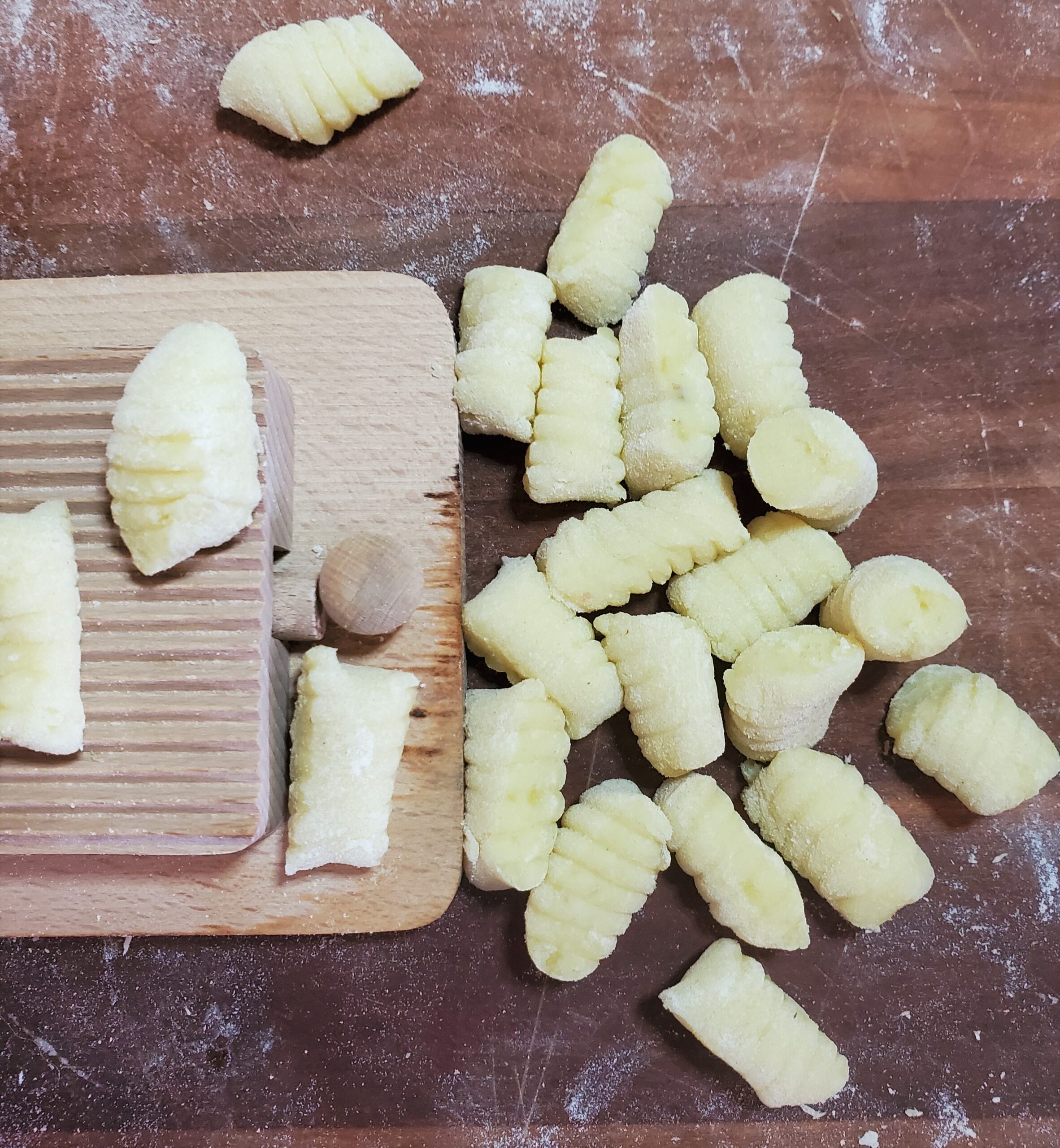
Homestyle Gnocchi
On April 29, 2021 by Christy LarsenNo big story (although there is always a story) to have to muck through to find out the deets on this one. This recipe is so simple you are going to wonder why you don’t have gnocchi every night of the week. I’m all for that, by the way! Here’s the ‘sitch—
You can scale this up and down based on how much you want to make, or how many potatoes you have in the pantry. Here is what you need to know. There are 3 ingredients to this–potatoes, 00 flour, and salt. The recipe is a ratio 10:1 + a pinch by weight. 10 parts cooked potato to 1 part 00 flour plus 1 nice pinch of kosher salt. I suggest that you make a minimum of 200 grams potato, which is nice for a giant personal batch or a starter serving for 2.
To cook the potatoes, you can peel, cut into chunks and boil in salted water…or you can peel and cut in small chunks, place in a small bowl, add a quick splash of water and a pinch of salt. Cover with plastic wrap and place in the microwave and cook for 3 minutes. Check to see if they are very soft, and if not cook one more minute at a time until the potatoes mash at the push of your thumb. While they are still hot, weigh and mash. You can use a fork for a very rustic approach, or a food mill for a more refined mash. Add 10% 00 flour (by weight) of the potato. If you have 200gr potato, you will have 20 gr 00 flour. Add another pinch of salt and mix together. Knead everything until you have a nice pliable dough.
Roll the dough into a long snake about 1/2″ thick. Cut the snake into squares and then use a fork or a ridged board to make marks into the dumplings and set aside.
Boil 4-6″ of water in a medium pot. Throw a couple of gnocchi in the hot water to test the structure and salinity. Allow the gnocchi to pop to the surface of the water, then wait a beat. Remove from water and taste to see if you need to add salt to the boiling water. Add salt if necessary.
Boil the rest in small batches, removing with a slotted spoon. Set aside while you make your favorite sauce. Reheat the gnocchi in the sauce to heat through.
You can refrigerate or freeze the leftovers–sauced or not.
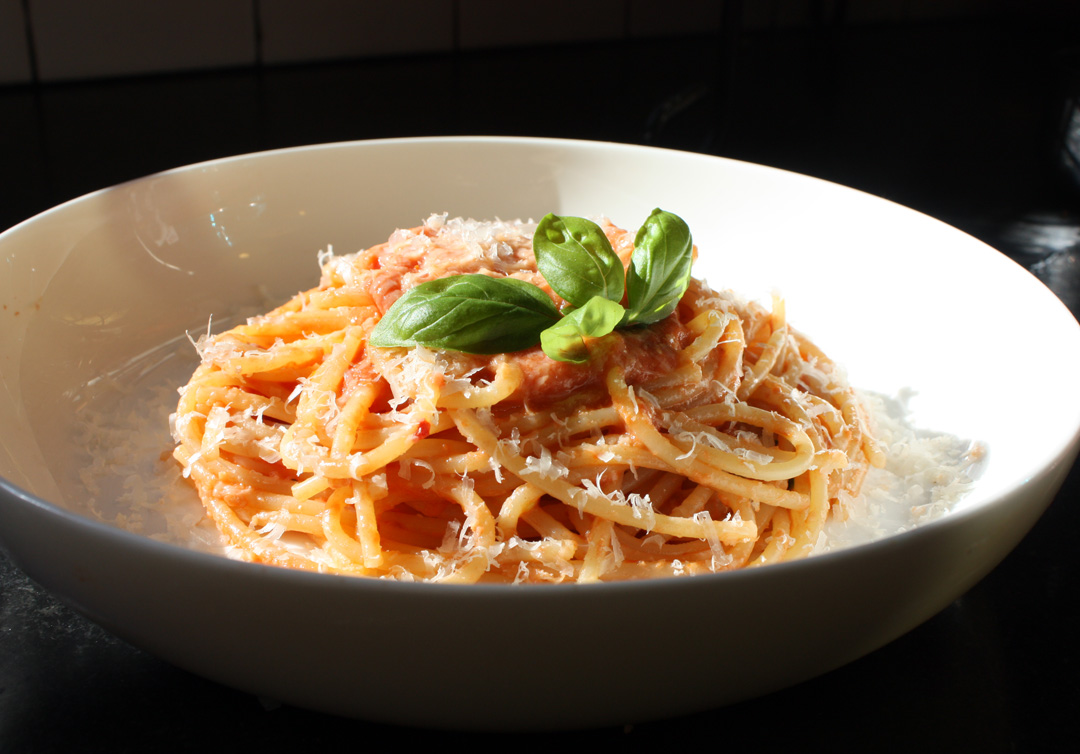
Spaghetti alla Vodka
On March 20, 2020 by Christy LarsenMy grandmother was famous for her alla vodka but not exactly like this. For one thing–she was a traditionalist and used penne. She also didn’t make her own tomato-infused vodka because she was a widow raising kids, with limited amount of time on her hands. Not all sorts like I do (she says with her tongue firmly in cheek). Our garden produced so many late harvest tomatoes that I found myself using them in a variety of ways; sundried, oven-roasted, confit, and soaked in vodka.
Tomato Infused Vodka
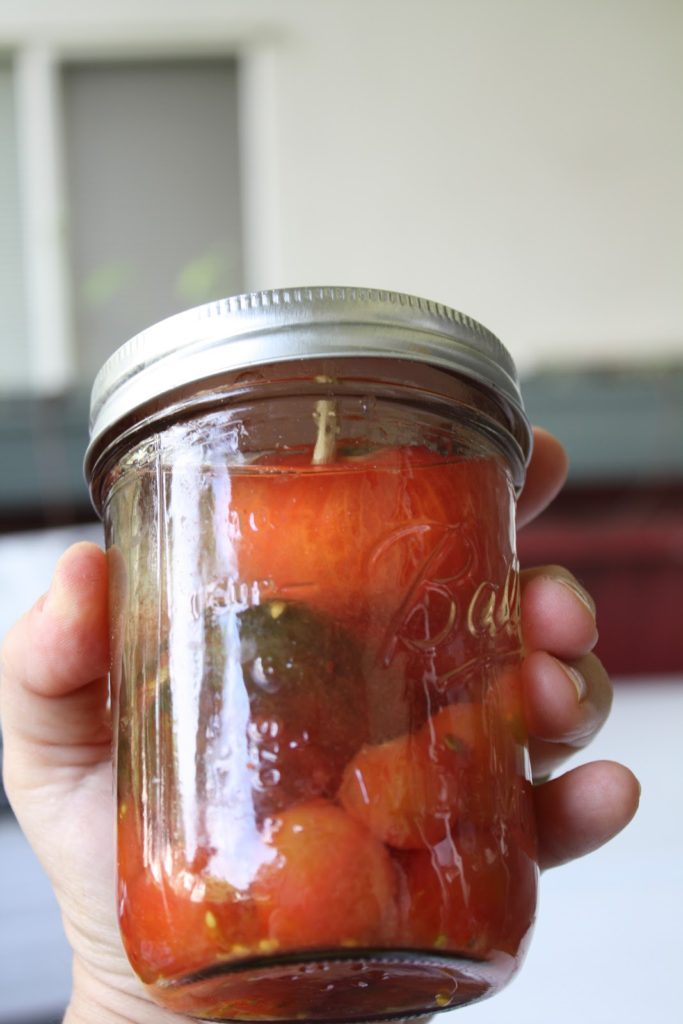
This is really simple. Peel tomatoes and cram into a jar, use a skewer to secure tomatoes if they start to float to the top. Fill the jar with vodka and store in the refrigerator for at least 5 days. I make several jars because I like to use the tomatoes and the vodka for my sauce. Leftover vodka is really great for a bloody mary.
Alla Vodka
1 lb spaghetti or pasta of choice
olive oil
1/2 of small onion–finely diced
2 garlic cloves–finely diced
6-8 basil leaves–chiffonade
1 large tin peeled whole tomatoes or combination of vodka soaked tomatoes and tinned tomatoes to equal about 4 cups whole
1/2-1 tsp crushed red pepper flakes
1/2 cup tomato soaked vodka (or another vodka you have on hand)
1/2 cup heavy cream
1/4 cup grated parmesan plus more for serving
Cook pasta in salted water, according to package instructions. Saute onions and garlic in olive oil over low heat, careful not to brown, but allow to get translucent. Meanwhile, place the tomatoes in a food processor or blender and pulse until smooth. When the onions and garlic are ready, add the tomatoes and vodka and let simmer for about 10-15 minutes. Add the basil, red pepper flakes, and heavy cream. Allow to heat through then stir in parmesan, and toss in the drained pasta. If the sauce seems too thick, use a bit of the pasta water. Shave a bit of parmesan on top of each individual serving, along with additional crushed red pepper, if you like spicy.
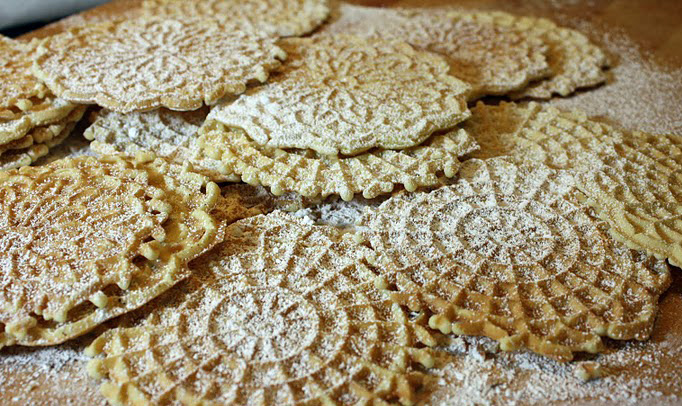
Pizelle
On December 15, 2015 by Christy LarsenI learned to make pizzelle at the knee of my great-aunt rose when I was quite young. She was an amazing baker and a real stickler about cleanliness. It was more than once that the “no lick” rule was enforced. Each time i lift my pizzelle iron from its tattered and batter-scarred box, I am reminded of holidays past. Memories of my dear aunt rose float richly in the fragrance of these cookies. The season begins…
Pizzelle
3 1/2 cups flour
1/4 tsp kosher salt
1 Tbs + 1 tsp baking powder
4 eggs
2 egg yolks
1 1/2 cups granulated sugar
3 Tbs Anise flavored extract
4 oz unsalted butter–melted and cooled
Combine the flour, salt, and baking powder in a large bowl. In another bowl, whisk the eggs, yolks, sugar, extract and melted butter. Stir into the flour mixture. this batter will be nice and thick, similar to a pate a choux. Drop by the spoonful onto a hot pizzelle iron. Check after 60 seconds for color. You want it to be a light blonde in color. Do not undercook, undercooked pizzelle will not get nice and crispy. Sprinkle with a bit of powdered sugar and serve.
You can form these into cones or cups, or even cut in fourths while they are still warm.
I like to use them for large and beautiful ice cream sandwiches…or rolled and filled with a bit of brandy flavored whipped cream…but I mostly like them just as they are

Italian Fig Cookies {cucidati}
On December 14, 2015 by Christy LarsenTo be honest this is more of a st. joseph’s day treat than a christmas one but truth be told they are good any time of year. Be warned this is not a fig newton facsimile. These are spicy and heady; filled with riches wrapped in a buttery italian pastry called pasta frolla. My presentation isn’t typical either. These are typically rolled in a tube-shape and cut in sections. On a cookie tray I find them to stay fresher longer, when presented like this.
italian fig cookies
cucidati
pasta frolla
4 cups flour
2/3 cups granulated sugar
1 tsp baking powder
1 1/4 tsp kosher salt
1 cup unsalted butter–cold and cut into pieces
4 large eggs
1/2 tsp vanilla
using a food processor, pulse together the flour, sugar, baking powder, and salt a few times to ensure fully mixed. drop in the butter and pulse until the butter has incorporated completely turning the mixture into a powder. add the eggs and vanilla and continue to pulse until the dough forms a ball. remove and wrap in plastic wrap and place in the refrigerator for a few hours or overnight.
filling
12 oz dried figs (i use calimyrna)
1/2 cup currants or raisins
zest of 1 orange finely grated
1/3 cup blanched, slivered almonds–toasted
1/3 cup bittersweet chocolate–cut into pieces or chips
3 heaping Tablespoons apricot preserves
3 Tbs dark rum
1/2 tsp ground cinnamon
light pinch ground cloves
1/4 tsp ground nutmeg
egg beaten with a bit of water for egg wash
powdered sugar glaze or royal icing for decoration
sprinkles for decoration
If the figs are hard and dry, place them in a bowl of hot water to soften, drain and then proceed with recipe. Dice the figs and place in a bowl with the rest of the ingredients. Stir to fully incorporate. place the entire mixture in the food processor, fitted with steel blade and pulse until you have a paste. Place in the refrigerator until ready to use.
Roll the dough out to 1/4″ and cut with a small round, plain or scalloped cookie cutter. Place just a small bit of fig on top of half the cutouts. Brush a bit of egg wash with a brush on the outer edge of the dough. Place a second piece of dough on top and press with tines of fork or toothpick to seal. Brush top with egg wash. Bake at 350 for about 10 minutes. You have to watch to see that they don’t burn, you want them just starting to brown on the bottom. When cool, leave plain or drizzle a bit of powdered sugar glaze (powdered sugar and milk to a runny consistency), or royal icing and add a few sprinkles.
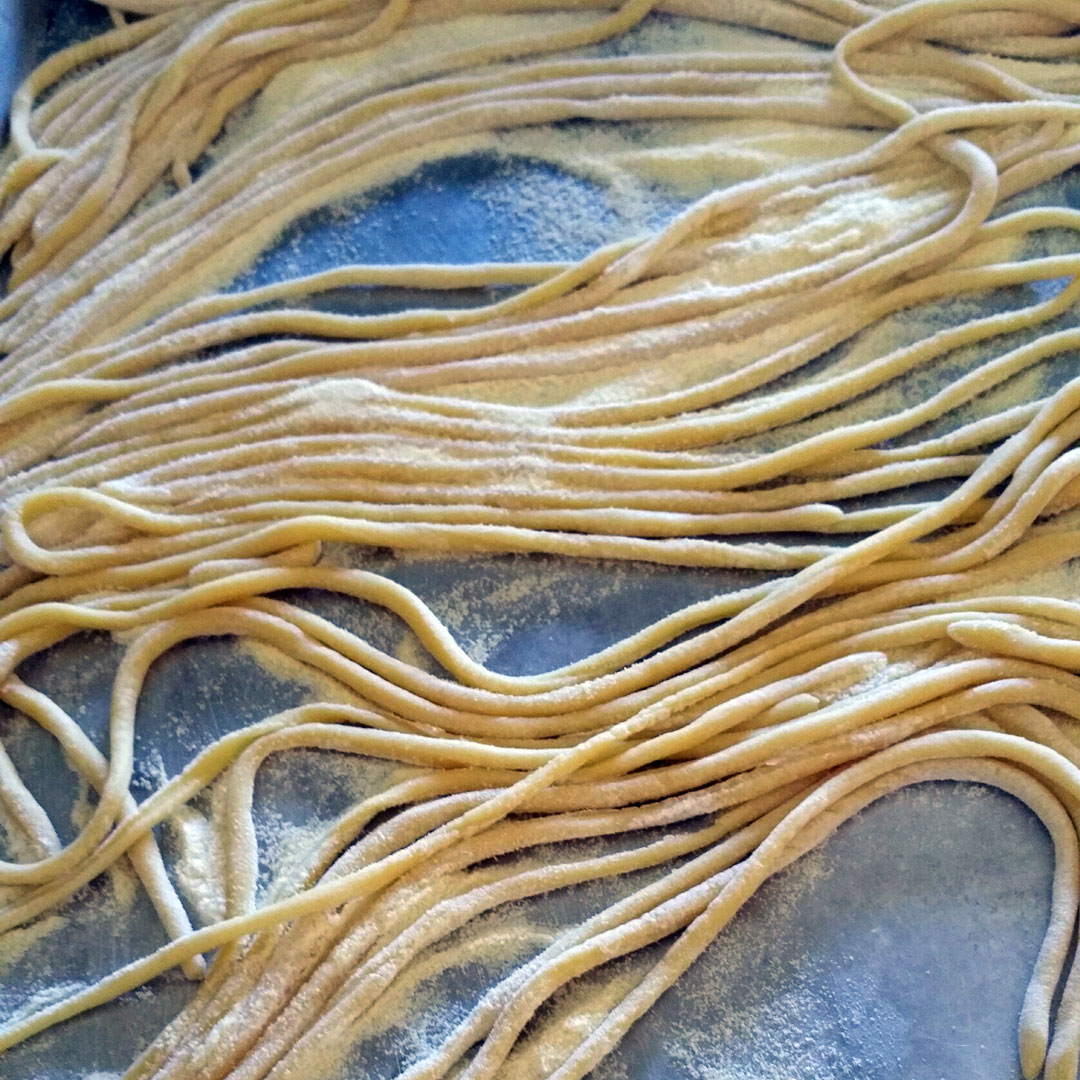
Pici Pasta
On April 26, 2015 by sixtyacrebakerPici pasta is a favorite of mine. When I see it on a menu, I order it. Pici is in a class of its own. It is fresh and chewy, and incredibly slurpable. Truth be told, I use this dough for my cavatelli as well, because of the chew factor.
When I was a kid, my grandparents would arrive on the day summer vacation began and stay until labor day. Some kids would come back from summer vacation, tanned, thin and 3 inches taller than they were when they left? Not this kid. My belly would be slightly rounder, I’d rattle off Italian phrases like I was Sophia Loren. I knew who Sophia Loren was. I was tan. We’d spend long evenings on the sun porch, eating, laughing, listening to the radio, and playing cards. My grandfather was an ace gin player and at a penny a point, we barely noticed our piggy bank dwindling. The food we ate was always delicious, and always from scratch.
Upon the gran’s arrival, the suitcases were hauled into the kitchen and unloaded. It was like Christmas. Literally. Grandma Grace would bring the Christmas stockings she collected from her bank and held from December until June. They were filled with hard candy and cheap toys; we loved them…and her for carrying on this tradition far longer than we really deserved. The grandmas were a tag team. Although they only saw each other this one time a year, they collaborated all year on what to bring with them to California. Out of the cases would come whole salami and prosciutto, buckets of polly-o and parmesan, capers, olives, anchovies. They were like traveling deli salesmen.
We didn’t think it odd at all.
Around day two or three the pasta making began in earnest. The dining room table, the pool table, the kitchen table, were all covered in sheets and dusted with flour. The pasta roller was brought down from the high shelf in the service porch and everyone was enlisted in the task of making pasta. We had one shot at making enough pasta for the summer. Mapping out how many dinners, who would be visiting, how much would each person eat, and what type and shape of pasta was a bit of an ordeal. The kitchen a bustle, until pasta making began. The room became silent. Everyone with a task; everyone working toward a common goal.
My job was always to transfer the pasta from the kitchen to its assigned table. Sometimes, most times, more went into my mouth than on the table. yes raw. Especially if it was cavatelli. I just loved the chew.
Still do.
Which is why I love this recipe. It has that bit of a chew. It also has a raw egg, so eating it uncooked is a risk you have to decide about on your own.
Semolina Pasta Recipe
*use for pici, cavatelli, orecchiette
2 cups 00 flour
1 cup semolina flour
3/4 tsp kosher salt
1 extra large or jumbo egg (i use a duck egg)
1 Tbs olive oil
1/2 cup (+/-) cool water
Place 00 flour, semolina flour and salt in a large bowl. Mix to combine. Make a large well in the center of the flour and fill with egg, olive oil, and 1/2 cup water. Using a fork mix together until all flour is moistened and the mixture is coming together. Use your hands to get the dough together in a ball. Turn out onto a floured work surface and knead for approximately 10 minutes. The dough should not be wet, and it shouldn’t be scraggy, but it should be a bit stiff. If the dough is too wet, use a bit of flour when you knead…just a bit at a time.
Wrap in plastic wrap and place in the refrigerator for about 1 hour.
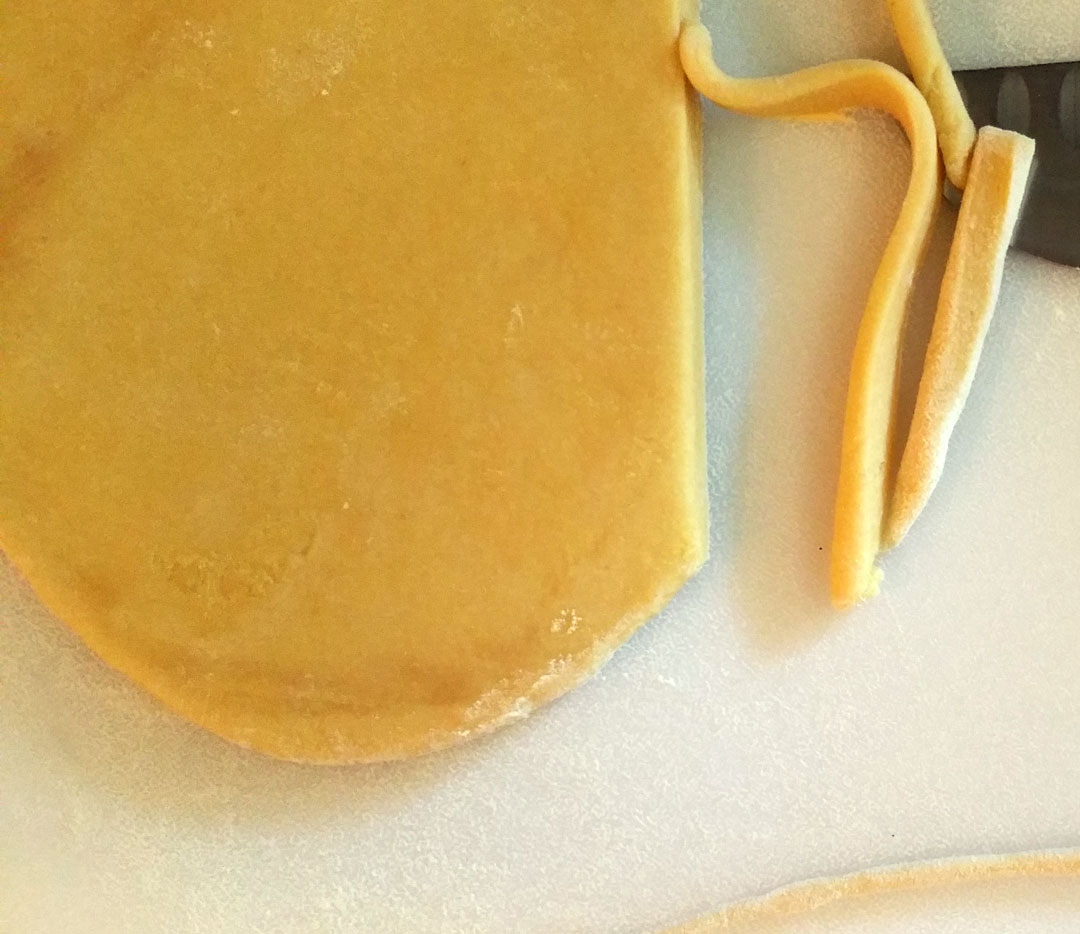
To roll out the pici:
Roll the dough with a rolling pin, on a lightly floured surface to about 1/4″ thick. Using a knife, cut the dough into strips about 1/8″ wide. Gently roll each piece on a lightly floured surface, starting from the center, and work your way out. Place on a tray dusted with semolina flour.
Cook in a large pot of salted boiling water for about 8-10 minutes. Serve with your favorite ragu.
** pici pasta is not spaghetti. it is thicker and a bit denser. As I said before, it has a bit of a chew to it.
Here is a short video demonstrating how to roll out your pici
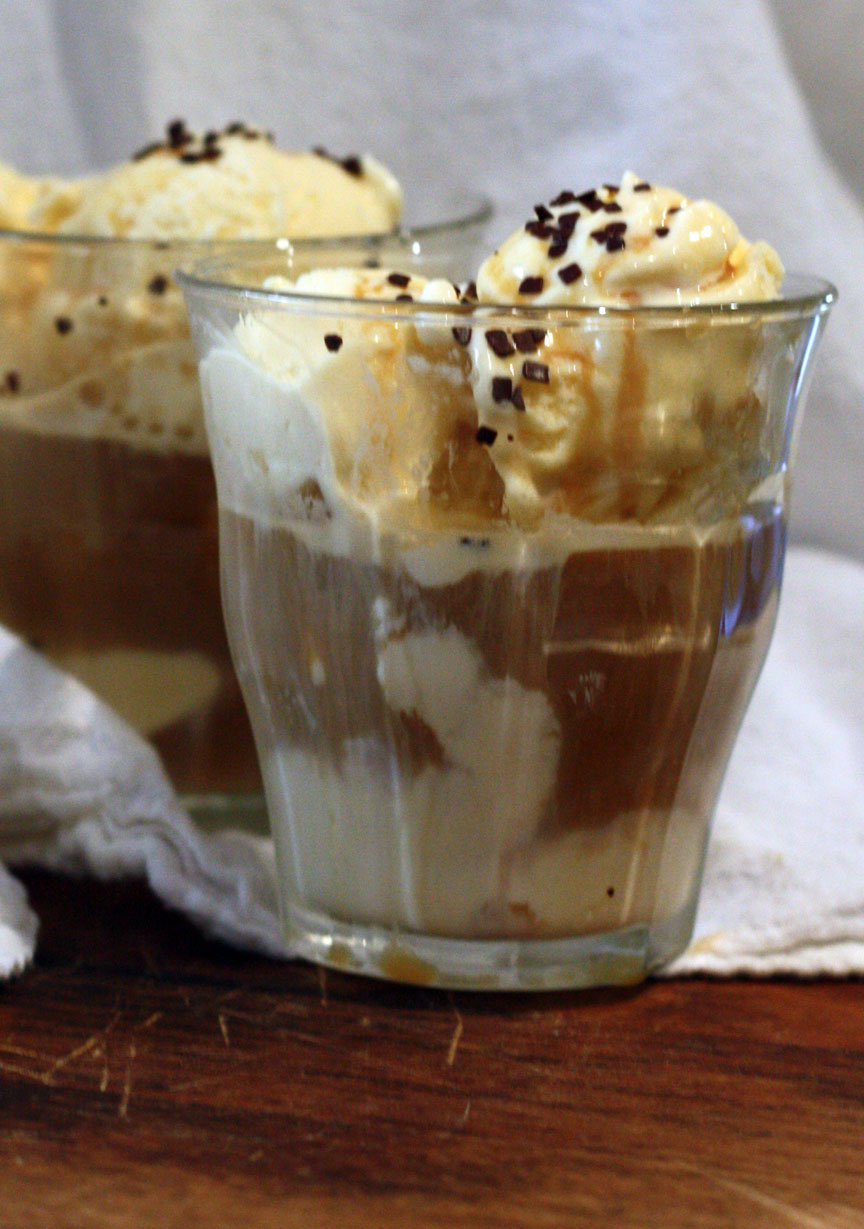
Affogato
On February 28, 2013 by sixtyacrebakerSometimes afternoons call for a snack; a pick me up that is both frozen and warm, and punched with caffeine. When the mood strikes, fix yourself one of these.
Affogato
vanilla ice cream
shot of espresso
This is not a sundae…nor it is meant to be a huge dessert. use a nice vanilla ice cream and give yourself a nice size scoop. While your shot of espresso is still warm (but not piping hot), pour over the ice cream. The espresso will melt the ice cream, so don’t linger too long….
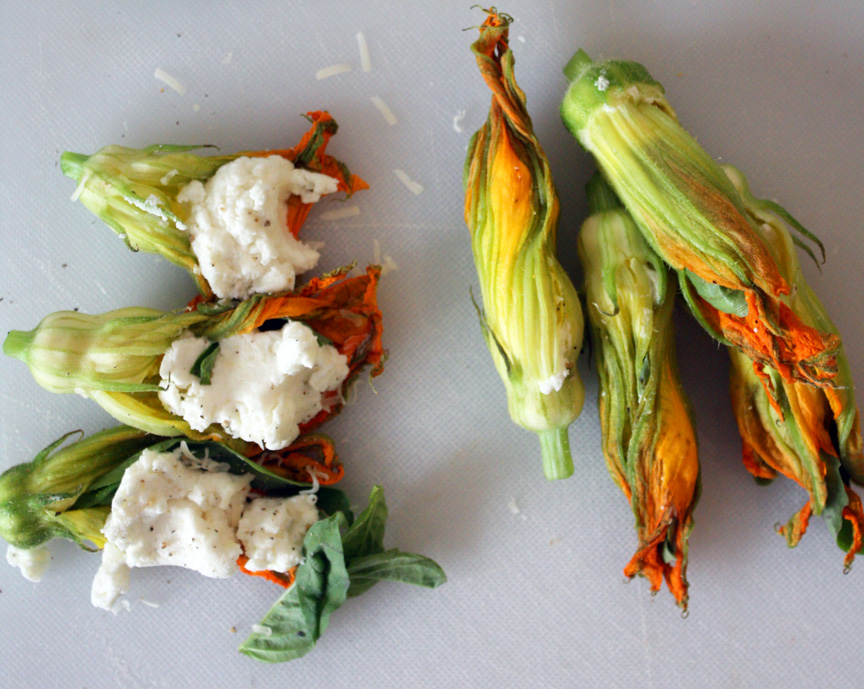
Fiori Fritti
On June 6, 2012 by sixtyacrebakerEver since I was a child, summer meant; long days in the pool, big family gatherings, and fiori fritti. Squash blossoms picked before the dew dried, were gently washed, stemmed, stuffed, battered, and fried.
I picked my first flowers of the season this weekend, and filled them with fresh chevre, basil & parmesan. After dipping them in really cold batter, I simply fried in olive oil. Delicious.
Fiori Fritti Batter
1/3 cup flour
1 egg
pinch of salt
pinch of pepper
1/4 cup sparkling water
2-3 ice cubes
more salt for sprinkling on the fried goodies when they come out of the oil
Whisk together the flour, egg, salt, pepper and sparkling water. add the ice cubes and place in the fridge while you heat the oil and prepare the flowers. the trick for a crispy batter is to have it very cold. Place about 6″ of vegetable oil in a sturdy pot—careful to leave another 3-4″ from the top of the oil to the top of the pan for safety. Dip the stuffed flowers in the batter and let the excess run off. Fry in the hot oil until begins to brown and is quite crispy.

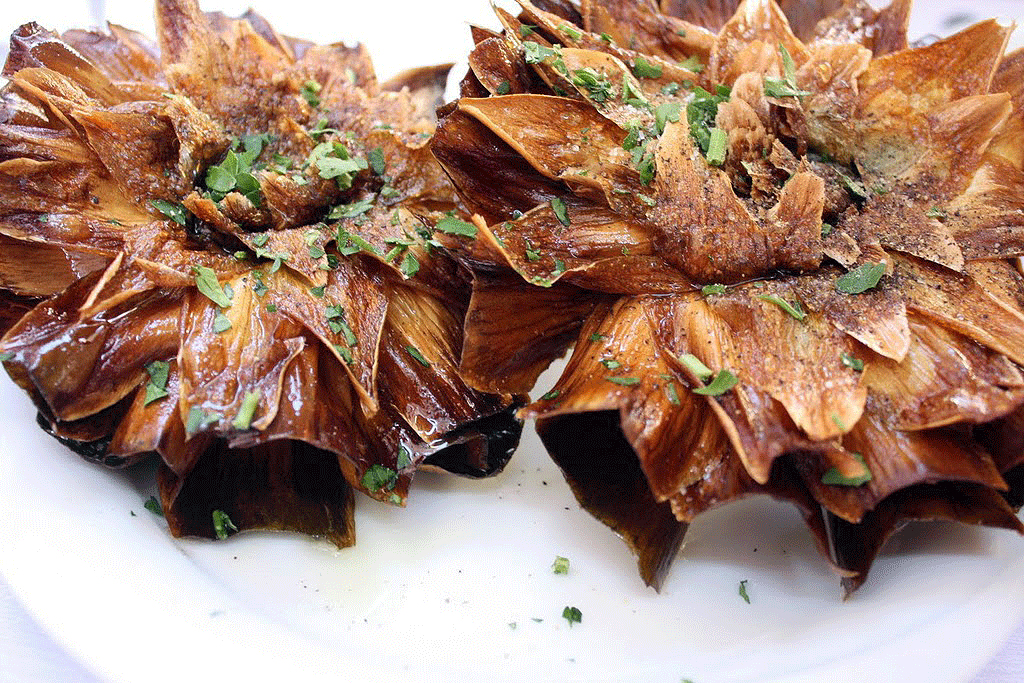
Fried Artichokes
On December 4, 2011 by sixtyacrebakerMuch like finding crawdads in Louisianna, brisket in Texas and barbeque in Memphis, you can find specialties in each Italian region. Rome is no exception. It also has something really special; the Jewish Ghetto. It is very small and virtually abandoned come dusk on Friday. It has a cuisine of its own. The most famous item is possibly the fried artichoke.
Carciofi alla Giudia
serves 4-6
4-6 chokeless or baby artichokes
lemons
olive oil for frying
salt and pepper
italian parsley (for garnish)
Fill a large bowl with cool water. Squeeze the juice of 1 lemon into the water and stir. trim each artichoke, removing all tough outer leaves and trimming the stem (do not remove entirely). Toss the trimmed artichoke into the lemon water to prevent discoloration.
*if you cannot find chokeless or baby artichokes, you can use any artichoke, however, you must trim it to the tender leaves, cut off the prickly tops and remove the choke prior to placing in the water.
Heat at least 3-inches of oil on the stovetop to 325 degrees. Meanwhile, remove the artichokes from the water and place on paper towel to dry. Place each artichoke stem side up on the counter and gently push to flatten, being careful not to break the leaves. Place in small batches in the hot oil and cook until soft, but not browned. Remove from oil and place on paper towel or kitchen paper to drain and cool. Allow to sit at least 30 minutes, and up to 3 hours. Just before serving, heat the oil to 375 degrees and fry the artichokes, careful not to crowd the pan, until they are browned and very crispy. depending on the size of the artichokes this can take as little as 5 minutes and as long as 10 minutes.
remove from pan, drain slightly. Sprinkle with salt and pepper. Serve with a garnish of chopped parsley and a lemon wedge.
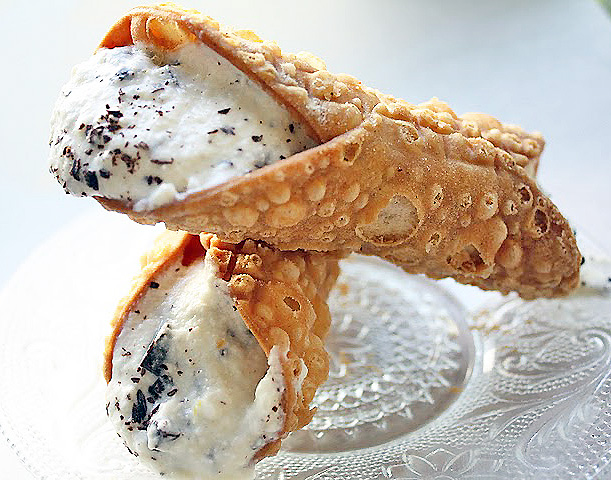
Cannoli
On March 19, 2011 by sixtyacrebakerOn March 19th Italians celebrate St. Joseph in gratitude. During a drought and subsequent famine, in Sicily, the faithful prayed to St. Joseph in hopes he would intervene. When the prayers were answered with rain and a successful harvest, the people of Sicily vowed to give thanks. Yearly. For eternity. Today, you may find Italians wearing red, praying in churches, preparing the altar and abstaining from meat. You will also find this Italian enjoying sweets. This is a day of reverence and joy. Last year I dispensed sage advice <em?if you want to read it, click here. This year you get a recipe.
Cannoli
shells
(you can buy them..there isn’t a prize for the person who slaves over hot oil all day making these)
2 cups all purpose flour
2 Tbs crisco or lard
1 tsp granulated sugar
1/4 tsp salt
3/4 cup marsala wine
1 egg–whisked with a bit of water
Combine the flour, sugar, salt and lard together. Slowly add the marsala while kneading the dough. Continue working the dough until it is well mixed and a rather hard dough is formed. Cover with plastic wrap and let sit an hour and up to 3 hours. Roll the dough out to 1/4″ sheet and cut with a 4-5″ round cutter. Quickly run a rolling pin over the rounds in 1 direction to form the rounds into ovals. Place a metal tube in the center of the oval and bring the sides up, overlapping enough to form the shell. Brush seams with a bit of egg wash to seal.
Heat oil in a pot. Drop the shells a few at a time into the hot oil and fry until they are light brown and bubbly. Remove from oil and place on greaseproof paper. Allow to cool long enough to handle, then slide the tube out and allow the shells to fully cool.
filling
1 1/2 lbs ricotta–drained to remove excess moisture
1/2 cup powdered sugar
pinch kosher salt
1/2 tsp vanilla
1 Tbs finely grated lemon peel
1 tsp fresh lemon juice
1/2 cup mini semi-sweet chocolate chips or chopped bittersweet chocolate
Mix all ingredients together and let sit in the refrigerator for a few hours for the flavors to meld. Filled cannoli shells tend to get a bit soft after time. If you want your shells to remain crispy, wait until you are ready to serve before filling them.
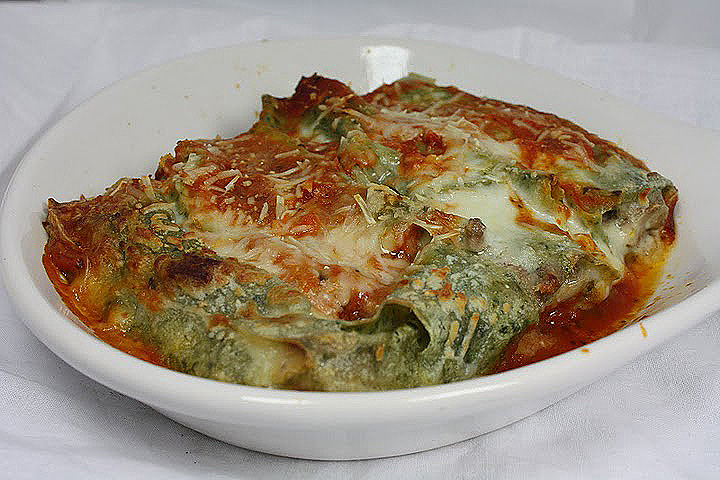
Cannelloni
On February 16, 2011 by sixtyacrebakerAfter dinner Mike leaned in real tight and whispered; “you make a great lasagna.” This is delicious, but lasagna it is not.
Cannelloni
adapted from mario batali
fresh pasta sheets–boiled and shocked in ice water
For Filling
olive oil
1/2 lb ground pork
1/2 lb lean ground beef
1/2 cup grated parmesan cheese
1 generous Tablespoon flour
1 cup milk
1 egg–lightly beaten
pinch freshly grated nutmeg
salt and pepper to taste
Glug enough olive oil to just cover the bottom of skillet. Add pork and beef and cook until no longer pink. Drain off excess fat. Stir in flour. Add milk and Parmesan cheese. Cook on low for about 10-15 minutes until thickened. Remove from heat. Let cool a bit, then add egg, nutmeg salt and pepper. Let cool completely while you boil pasta.
For Tomato Sauce
use your favorite recipe or even a bottle sauce…you need only a little for this recipe
For Besciamella
3 Tbs unsalted butter
3 Tbs flour
1 1/2 cups milk
1/4 cup parmesan cheese
1/4 tsp nutmeg
pinch salt
Melt the butter in a saucepan. Whisk in the flour and cook for just a minute or two. do not brown. Whisk in milk and bring to a simmer. As it begins to thicken, add the Parmesan, nutmeg and salt. The sauce is to be thickened, but not gooey. It is a sauce.
To assemble
Place a bit of tomato sauce in the bottom of an oven safe dish. Use a very generous tablespoon of meat for each cannelloni. Place meat in the center of the pasta sheet and spread evenly. Roll the pasta into a tube, leaving the ends open. Place in the prepared dish. Repeat with remaining meat and pasta. Once completed, cover in beciamella, swirl in a bit more tomato sauce. Sprinkle with Parmesan cheese. Bake at 350 until heated through and the beciamella begins to bubble.